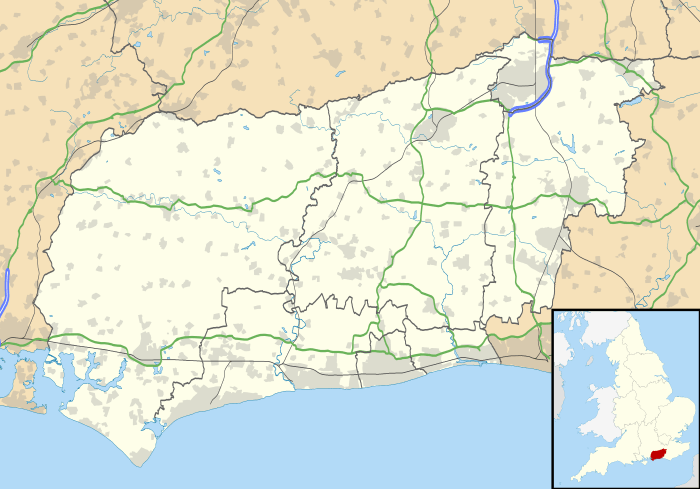Marlipins Museum
| Marlipins Museum | |
|---|---|
|
The building from the southeast | |
| Location | 36 High Street, Shoreham-by-Sea, West Sussex BN43 5DA, United Kingdom |
| Coordinates | 50°49′55.18″N 0°16′34.25″W / 50.8319944°N 0.2761806°W |
| Built | 12th century |
| Architectural style(s) | Norman |
| Governing body | Sussex Archaeological Trust |
Listed Building – Grade II* | |
| Official name: Marlipins House | |
| Designated | 8 May 1950 |
| Reference no. | 297291 |
 Location of Marlipins Museum in West Sussex | |
Marlipins Museum, is a 12th to early 13th century Grade II* listed building[1] on the High Street in Shoreham-by-Sea, a town in Adur district in West Sussex, England. It is distinguished by its chess-board pattern of stone flint on its frontal façade.
The initial estimate of the date of the building is thought to be 12th century based on new evidence which has emerged following the demolition of the adjunct building during the construction of the new annexe. The northern wall was originally constructed between 1167 and 1197 and that this was demolished and replaced by a new wall in the 15th century.
It is thought to be the oldest complete secular building in Britain.
The Caen stone frontage is thought to have been added in the late 13th to early 14th century along with other renovations. Repairs and reconstruction then took place to the roof in the 15th century and new timbers installed in the 16th century.
Origins
There are various theories about the origins of the building and its intended purpose. These theories range from it being a storehouse for wool and hides, a hospital, the remains of the Carmelite Priory, and even a meeting-house for the Knight Templar. There have also been suggestions it was built for ecclesiastical purposes but there is no real evidence for this.
The buildings may well have served as a Court of Piepowders (dusty feet) for those frequenting the markets held outside its doors, whilst it might have originally been built by the de Braoses as their depot in the town (they dwelt at nearby Bramber Castle).
History
The deeds for Marlipins survive back to 1347. These deeds describe Marlipins as an 'Oat Market on the corner of Moderlove Street' (a corruption of its modern name 'Middle Street') Later when it belonged to the Prior of Lewis it became known as 'his cellar.'
1346: The deeds show the Marlipins building (now a Museum) sold by Stephen Must. It is described as a stone corner tenement called 'Malduppine' situated in the Otmarcat.
1489: Procession Street is described on the south of the Malapynnys. the building is described as a certain cellar ..... chamber or loft above the cellar built and sold to a merchant of Suthampton.
1703: Current spelling of Marlipins seems to have been first recorded.
1900: A Descriptive Catalogue of Ancient Deeds: Volume 3, by H.C. Maxwell, includes the entry "Grant by John Sharpe the elder, of New Shorham, husbandman, to Thomas Dymmocke of Suthampton, merchant, of a cellar with a chamber or loft above it, called 'Malappynnys,' in New Shorham, between the street called 'Moderlove strete,' and a garden of the lord of the said town, and another street called 'Procession strete.' 8 September, 4 Henry VII. Fragment of seal." H. C. Maxwell Lyte (editor) (1900). "Deeds: A.4101 - A.4200". A Descriptive Catalogue of Ancient Deeds: Volume 3. Institute of Historical Research. Retrieved 8 June 2012.
1922: The Marlipins is purchased by the Sussex Archaeological Trust; this Trust being created by the Sussex Archaeological Society to manage its properties (plaques with this name can still be seen at Lewes Castle, Anne of Cleves House Museum and the Priest House. The building was in a bad state of repair and the renovation was made primarily with local contributions. It was opened as a museum in 1928, and is one of several properties administered by the Sussex Archaeological Society.
Today
Today the museum holds permanent displays which concentrate on Shoreham's important maritime past and the local history of this part of Sussex. The Archaeology Gallery looks at the Shoreham area from early prehistory to medieval times. Pictures from the extensive art collection are changed regularly and displayed at the two new galleries recently built.
The building was listed at Grade II* by English Heritage on 8 May 1950.[1] Such buildings are defined as being "particularly important ... [and] of more than special interest".[2] As of February 2001, it was one of six Grade II* listed buildings, and 119 listed buildings of all grades, in Adur district.[3]
References
- 1 2 "Detailed Record: Marlipins Museum, High Street, Shoreham-by-Sea, Adur, West Sussex". Images of England. English Heritage. 2007. Retrieved 2009-12-15.
- ↑ "Listed Buildings". English Heritage. 2010. Retrieved 19 August 2011.
- ↑ "Images of England — Statistics by County (West Sussex)". Images of England. English Heritage. 2007. Archived from the original on 2 January 2013. Retrieved 2 January 2013.
External links
| Wikimedia Commons has media related to Marlipins Museum. |
- Sussex Past Site - most current information
- Marlipins Adur Site
- Friends of Marlipins Museum
- Shoreham History Portal
Coordinates: 50°49′55.18″N 0°16′34.25″W / 50.8319944°N 0.2761806°W
.jpg)